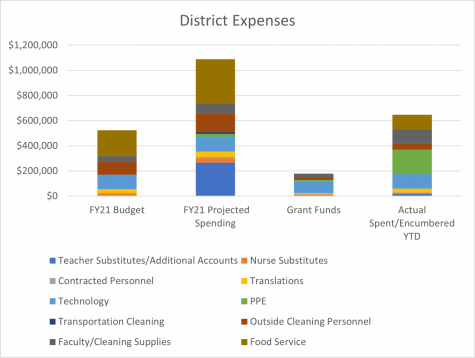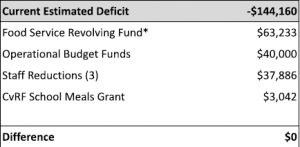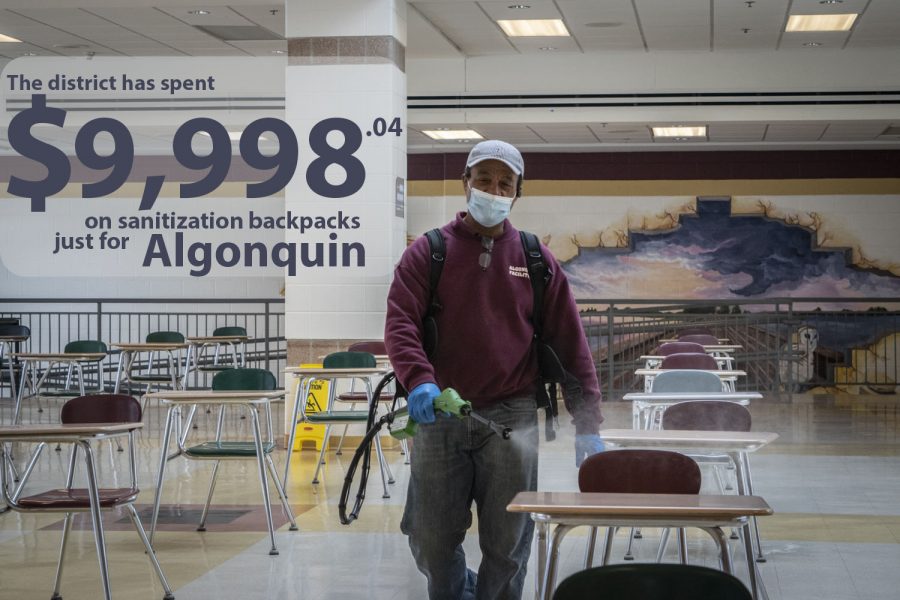In order to allow students to safely return to school this year, Algonquin was required to pick up almost $500,000 in new expenses, though much of that has been offset by grants.
According to a presentation by Director of Finance Rebecca Pellegrino to the School Committee on Jan. 20, the largest new expenses came from additional staffing requirements and changes to the Food Services program, along with new cleaning costs. The district has been employing a number of strategies to help recuperate the new expenses, though its goal is to do it in a way that will not negatively affect students.
“My hope is that any decisions we made to open school for in-person learning benefited students and were made independent from the cost-saving [measures which were taken],” Principal Sean Bevan said.
General Expenses and Grants
In his first year as principal, Bevan has experienced financial and logistical challenges that many administrators would never see.
One struggle Bevan noted was that budgets for a school year are created nearly a year earlier.
If you think back to November [2019]… nobody was aware that we were going to have all these [cleaning and operational] unanticipated costs.
— Principal Sean Bevan
“The budget development process begins in the late fall the year before the school year where those funds are going to be applied,” Bevan said. “If you think back to November [2019]… nobody was aware that we were going to have all these [cleaning and operational] unanticipated costs.”
According to Bevan, the most difficult expenses for the school are “old expenses” that “require income that we don’t have coming in.”
Superintendent Gregory Martineau believes the most significant new expenses are Personal Protective Equipment (PPE), air purifiers and signage.
According to Martineau, a hold was put on expenditures to allow the district to evaluate if a purchase is essential.
“Becky [Pellegrino] is reviewing every requisition and request for expense,” Martineau said in an interview via Zoom.
In addition to reviewing every expenditure, Pellegrino has been taking advantage of grant funds to help offset new costs. According to the presentation, the district has received approximately $390,000 in grant funds from the state and federal government this fiscal year.
These grants include a $314,000 grant from the state (funded by the CARES act) which gave districts $225 per pupil and a $44,000 grant which was built into the state budget.

Many of the new expenses (outlined in the sidebar) have had minimal effects on students’ learning experiences.
While Algonquin’s revenue streams, such as athletic ticket sales and facilities rental income, have been impacted by the pandemic, according to Bevan and Martineau, this has not impacted academics.
“The thinking in municipal and school funding… is that money coming in should be spent on the area directly related to where that money was generated,” Bevan said.
Thus, the income generated in one area only affects that area, meaning that a lack of gate receipts from athletics only impacts athletics.
According to Athletic Director Micheal Mocerino, in order to compensate for the lack of gate receipts, which typically brings in $40,000 per year, no new uniforms have been purchased this year. However, careful consideration will be given to purchasing them next year.
Mocerino also noted that because the seasons are shorter, the transportation cost has gone down, which is helping to compensate for the lack of income.
Changes to Staffing
“As of now, we are very fortunate from the teaching and custodial side,” Director of Operations Keith Lavoie said in an interview via Zoom. “None of the teachers had to be laid off.”
According to Pellegrino, even though no teachers were laid off, some empty positions, such as those left by teachers who retired, were not filled.
We tried every other way to keep people employed for as long as we possibly could, but it was no longer possible for financial reasons only.
— Keith Lavoie, Director of Operations
In addition to not having to lay off any teaching staff, the district has employed “building-based subs.” These substitute teachers are assigned a regular schedule at each school (instead of substitutes being called in the morning of a known absence).
According to Martineau, having three employees focused on substituting has saved the district some money, but the “substitute teacher” line item is still over budget. Martineau hopes the district will continue this practice in the future, as it provides some consistency for school administrators.
Martineau said that when making cuts to the budget, he strives for a “people-first approach.” This means that if savings must be made somewhere, cutting staff will be the last option. Despite this, the school had to recently reduce the amount of cafeteria staff by three.
“It was an absolute last effort,” Lavoie said. “We tried grants. We tried every other way to keep people employed for as long as we possibly could, but it was no longer possible for financial reasons only.”
According to Pellegrino, these layoffs were necessary due to the unique way in which the cafeteria is set-up financially.
Food Services Program

“The food services programs are a bit unique in terms of our budget in that it’s really a self-funding self-operating program that sits outside of our typical operational budget,” Martineau said. “This is the first year in many that we’re actually having to use operational funds to subsidize the food services program.”
In other words, staffing for the food services program relies heavily on the income they are receiving.
“[In a normal year, we serve] about 700 lunches a day which was approximately 50% of the total population of kids, not to mention the other a-la-carte items available,” Lavoie said.
According to Lavoie, although all students can eat lunches for free this year due to a federal grant, the cafeteria is only serving between 150-250 lunches per day, in addition to 600 meals on Monday, which go to fully remote students. This is about an 80% decrease from a normal year.
Bevan noted that even though all free-for-student meals are being reimbursed by the United States Department of Agriculture (USDA), the significant decrease in lunches purchased has still made it difficult for the food services program.

“Even if you are getting reimbursed 100% for all your meals, if you are feeding half the number of kids than in a typical year, it only goes so far,” Bevan said.
The cafeteria is running at a deficit despite a higher income rate for each meal.
“[The reimbursement] is at a greater rate than when we typically collect our school lunches,” Lavoie said. “At Algonquin, $3.25 [is the] price for lunch and we are able to get $3.63 for every one of those lunches served.”
Enhanced Cleaning Costs
With a virus comes a significant amount of cleaning. Teachers are spraying disinfectant on every desk between classes and custodians clean throughout the night in order to keep the school safe and clean. These practices, while expensive, are not cheap.
According to the presentation, as of Dec. 31, the school spent over $115,000 on cleaning supplies, compared to the budgeted $48,000 and the Oct. projection of $81,000.
“We’ve been pleasantly surprised with our cleaning supplies,” Lavoie said. “We’ve certainly incurred an increase in that, but it hasn’t been so astronomical that it’s taken away from some of the other things we’re trying to do.”
One cleaning expense Bevan noted was the electrostatic backpacks custodians use to spray common surfaces like doorknobs and desks in the cafeteria.
“We did have an increase in some things we could have never anticipated,” Bevan said. “For instance, the backpack sprayers you see some of our staff using are several thousand dollars… Those were a cost we weren’t ready for and had to make work.”
According to Lavoie, additional cleaning personal have been brought on to help clean at night, which is projected to cost an additional $47,000.
Long Term Impacts
Martineau, Lavoie and Bevan expect few noticeable long-term effects of the increase in expenses from this year.
“I do not think that students will feel the impact,” Martineau said. “We tried to make that our priority.”
Martineau noted that the most major effect students might notice is the district’s inability to purchase some materials that would have been nice to have. He cited the example of new textbooks; while it would benefit students to have updated versions, continuing to use existing ones will do no harm.
Bevan is concerned about the learning gaps that may have occurred this year.

“I don’t think there will be long-term impacts to the budget, but I am worried that there’ll be long-term impacts to what kids have not learned,” Bevan said. “The worry is that students have not had the same experience in this year that they would have had in a more typical year, and as a result, there could be these learning gaps that we’re going to have to identify and try to rectify in the years to come.”
Despite the financial hardships the district is facing, Bevan hopes there will be a net-positive impact when it comes to how educators think about educating.
“We had to develop new ways to think about instruction and to think about how kids learn,” Bevan said.
Bevan believes there will be good that comes from this unusual and challenging school year.
“There could be certain [new ways to do things which] have benefits that… might stick around,” Bevan said. “For example, having all teachers on Canvas is something that would have been very difficult to require every teacher to do in a non-pandemic year.”
This story was originally published on The Harbinger on March 29, 2021.



























![IN THE SPOTLIGHT: Junior Zalie Mann performs “I Love to Cry at Weddings,” an ensemble piece from the fall musical Sweet Charity, to prospective students during the Fine Arts Showcase on Wednesday, Nov. 8. The showcase is a compilation of performances and demonstrations from each fine arts strand offered at McCallum. This show is put on so that prospective students can see if they are interested in joining an academy or major.
Sweet Charity originally ran the weekends of Sept. 28 and Oct. 8, but made a comeback for the Fine Arts Showcase.
“[Being at the front in the spotlight] is my favorite part of the whole dance, so I was super happy to be on stage performing and smiling at the audience,” Mann said.
Mann performed in both the musical theatre performance and dance excerpt “Ethereal,” a contemporary piece choreographed by the new dance director Terrance Carson, in the showcase. With also being a dance ambassador, Mann got to talk about what MAC dance is, her experience and answer any questions the aspiring arts majors and their parents may have.
Caption by Maya Tackett.](https://bestofsno.com/wp-content/uploads/2024/02/53321803427_47cd17fe70_o-1-1200x800.jpg)
![SPREADING THE JOY: Sophomore Chim Becker poses with sophomores Cozbi Sims and Lou Davidson while manning a table at the Hispanic Heritage treat day during lunch of Sept 28. Becker is a part of the students of color alliance, who put together the activity to raise money for their club.
“It [the stand] was really fun because McCallum has a lot of latino kids,” Becker said. “And I think it was nice that I could share the stuff that I usually just have at home with people who have never tried it before.”
Becker recognizes the importance of celebrating Hispanic heritage at Mac.
“I think its important to celebrate,” Becker said. “Because our culture is awesome and super cool, and everybody should be able to learn about other cultures of the world.”
Caption by JoJo Barnard.](https://bestofsno.com/wp-content/uploads/2024/01/53221601352_4127a81c41_o-1200x675.jpg)






